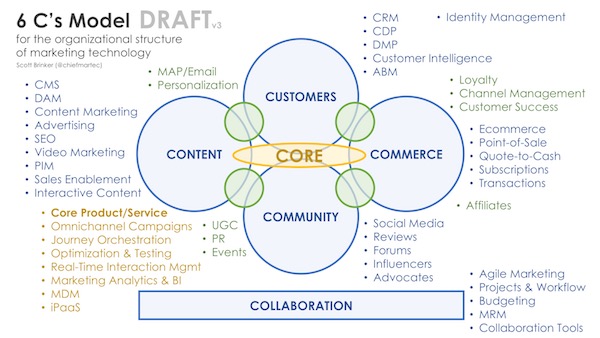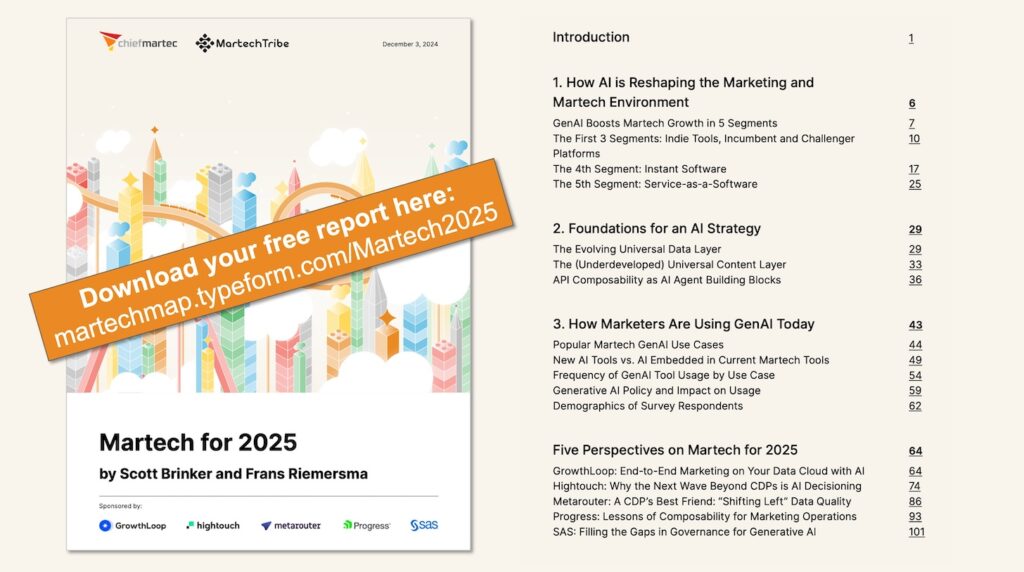The marketing technology landscape is big, broad, and deep. (Feel free to mentally insert other, more colorful, adjectives.) So many different kinds of solutions fall under that umbrella, and they don’t always fit into nice, neat categories.
This contributes to the confusion that many marketers feel around martech. It’s generally not clear what the taxonomy of the solution space is, which makes it difficult to break it down into smaller, more manageable chunks of capabilities. It’s fascinating to see how the marketers who submitted their marketing stacks to The Stackies have thought about this.
I think a good taxonomy isn’t just about vendor attributes, but also helps illuminate where different solutions fit in a marketer’s organization, the kinds of capabilities they enable, and the shared DNA in the practices that evolve around them.
It can’t be too complex, or it offers no real help to bringing order to the chaos. But it can’t be oversimple either, or it has no organizational power.
And, if it’s not asking too much, it would be nice if it had a catchy name.
Have wrestled with this challenge for 7 years, I’ve sketched dozens ideas in a notebook. Almost all of them have been crap. But there’s one that I’ve been chewing on for the past year that seems promising, so I thought I’d finally share a draft of it — The 6 C’s Model for Organizing Marketing Technology shown above.
It organizes marketing technologies into 6 domains that just happen to all start with the letter C (which was a wonderful stroke of serendipity, I swear):
- Customers — all the data about customers/prosects in our universe
- Content — all the content we produce and distribute in all channels
- Community — interactions with customers as a group, e.g., social media
- Commerce — capabilities to directly sell our products and services
- CORE — our product/service and campaigns/data that cross all of marketing
- Collaboration — the tools we use for collaborating inside marketing
I’ve mapped common “categories” of martech products (e.g., the alphabet soup of CMS, DAM, CRM, CDP, ABM, MDM, SEO, etc.) into these six domains to illustrate how I see these as clusters of related technologies. But it’s important to emphasize that what really gives meaning to these domains is the shared practices and organizational capabilities that tend to blossom within each of them.
(I’ve also noted a few of the interesting intersections, such as between content and customers, which is where most marketing automation, email marketing, and personalization solutions operate.)
I do think there’s different DNA in most organizations for how content assets, customer data, and community interactions are managed. And while breaking down silos — or at least spanning them or rearranging them for better common alignment — is important, there’s still unique skills, dynamics, and culture in each of these domains that are valuable to understand and nurture.
That’s why although it may be tempting to lump everything into the “core” that spans all of marketing, doing so would just bring us back to the big bucket of soup. The heart of the core has to be your own product or service, of course, and that’s the single biggest piece of the equation. But other full-span coordinating mechanisms, I think, benefit from leveraging the deep strengths of the other domains instead of overshadowing them with too heavy of a hand.
Anyway, I’d love your thoughts and feedback. It’s entirely possible that this model will crumble under further scrutiny too, and it’s back to the drawing board. But maybe, with a few tweaks and improvements from you, this could be the start of something useful.




Very interesting Scott, thanks for sharing. Certainly seems very logical to group these ‘parent’ categories to easily determine how the product categories play a part overall. You have quite accurately moved the idea away from it being brand centric to being concept centric… which does indeed put a new spin on the way we look at the ‘stack’ as a whole and maybe the focus we should, in turn, give to our ongoing martech strategies, as opposed to those ‘big’ brands that dominate our attention.
Ps: if you ever want to relieve yourself of those old notebooks, I’m sure there’ll be plenty of us willing to give them a good home! 😉
Thanks, Anneka!
Hi Scott, your work is nice and interesting too. My worry with many marketing propositions and concepts is that they come from one end but those who make these propositions and concepts fail to include this caveat. That is, the propositions and concepts do not state clearly those to whom such propositions and concepts apply to. The marketing policy makers or the marketing foot soldiers (the executors). This failure arises from over assumption that the propositions and concepts must fit all which fail some of the times if not more. secondly, the cultural environment of the users or supposed users of these propositions and concepts are seldom factored in such that many of them fail the litmus test outside the environment of the originators. By and large this your work will go a long way if you fine tune it along the line of this contribution. You can also have a look at the book, “A GUIDE TO PRACTICAL MARKETING” by this writer.
I agree with you! Very skeptical of universal frameworks. I’d feel more comfortable offering this as an “ingredient idea” rather than a “recipe framework.” I’m highly in favor of this morphing as needed to better fit an individual company’s martech sensemaking.
Well, this ain’t the OSI Model.
(Remembering fondly my days of developing OSI stacks.)
Hi Scott. Thanks for a thought-provoking approach. I very much agree that “content” needs to be raised to an equal status with other domains; this is something we see when we try to lay out architectures for our own clients. I also like the idea of a “core” where orchestration and analytics take place. The one thing that seems a little odd is that advertising is tucked away under content, while email and personalization are the intersection between content and customers. Perhaps you need … dare I say it…another C for “channel”.
Thanks, David.
I was thinking that marketing automation platforms (MAP) and personalization systems generally helped with matching content asset/data with customer data. Arguably intersects with commerce and community though in some cases — so maybe those things better fit with JOE and RTIM and other “decisioning” engines that inevitably have to live at the intersection of all domains to be fully effective.
Email on its own is probably mostly content — at least to the degree that “advertising” is too. I guess I was envisioning that the organizational disciplines around creating great content share more DNA with advertising (and email marketing?) than the 360-degree customer view mission.
But I agree, advertising is such a culturally unique cluster unto itself, it does feel a bit wedged into the larger content mission. Logically it is a kind of content — paid media content. But there’s more to it than that.
Representing channels in this model is an interesting thought… will chew on that. Thank you!
Scott — Thanks for sharing. It is useful to see a simplified framework for understanding the components of the marketing stack. While it is interesting to see the landscape of the many hundreds of solutions out there, that view serves more as a reminder of how fragmented (and crowded) the space is, than a driver of action. I’d offer up that in the end, the organizing principle for any CMO trying to decide where to start and where to put his or her undoubtedly too-scarce resources is to have a strategy that answers these questions: What are the customer problems my brand wants to solve? Where are we now on the journey to the solutions(s)? What does success look like? And what marketing capabilities (technology and otherwise) do I need to lead my team to get to the solution(s) that will create a widening competitive advantage. Mar-tech along with all of the other advanced technologies available today should be chosen because they can help the brand enable remarkable differentiation — in the hearts and minds of customers. With strategy in hand, it is a lot easier to make smart decisions about how to prioritize mar-tech investments for business leverage, and frameworks such as the ones you are sharing fit right in to supporting these decisions. Best, Amy
Hi Scott, One more thought — I was looking at your 6 C’s again this morning, opened up a “Marketing Framework” that I had written 3 years ago anchored in the hypothesis that all go-to-market basics have been redefined,
From the 6 Ps:
Price,
Product,
Promotion
Place,
Predictable,
Push/Pull
To the 6 C’s, which as it turns out are almost identical to yours, with one exception:
Commerce
Content
Customer
Community
Collaboration
Change
It’s kind of amazing (or crazy) depending upon how you look at it, that Kotler’s Marketing Management, still heavily grounded in the decades-old 4Ps model, is still a basic in marketing coursework. The old model was great in its time, and one can argue drove the function, but it’s time to think in whole new terms.
So great to hear we are thinking on similar paths — and I don’t have the zippy name for what you’ve got here, but I do think it’s about capabilities to enable strategy.
Happy Memorial Day! Hope to meet at the Fall conference!
Amy
I like “Change” being called out as an explicit marketing mission. More important than ever to have that as part of the organization’s operational mantra.
Scott
Thanks for the details . Change management seems to be taking center stage recently .Not only in Marketing aspect But also in Content and collaboration initiatives such as KM and RM
Thanks Amy for that contribution. Your first part of your thought, indeed your first question, “What are the customer problems my brand wants to solve?” or put the other way, what is the need of the customer or consumer my brand wants to meet? remains the “finito” of customer satisfaction that marketing is. Some of the times we introduce so many attributes and appendages and make things look so complex that we appear to miss our way in the confusion. And add to this is the fact that we also bring into the main stream of marketing concepts that should be appendages to assist marketing. For example, content marketing from the advertisement end is to help the marketer to introduce his/her product or service to the customer/consumer. This ought to be made clear so that the marketing manager can understand what each concept does and when to apply each, except all we are saying is just academic adventurism.
On the second part of your thinking, Philip Kotler’s 4-Ps are not sacrosanct but they remain useful model in understanding marketing principles. It can be modified, as you proposed, to meet peculiar needs provided the user understands the basics. It is part of knowledge expansion which is good but as I said in my earlier contribution, we should not lose sight of the fact that all we are trying to achieve is useful aid to marketing management for organizational growth and sustainability.
Scott, thank you for offering a more simplistic way of looking at the components of MarTech and showing their interaction and dependencies.
I love the alliteration and the relevance of the design to the customer experience.
I think about Data (about customers and in general) as foundational. Perhaps having Data and Content as bars across the bottom to depict them as the necessary components to successful customer experience could be a tweak.
Then work upwards using the transactional components (Core, Commerce et al) culminating with the Customer (not Data) at the top. Perhaps the level below the Customer could be icons depicting different channels (social, email et al).
At times when creating frameworks, I think of (but have never been successful in implementing) putting the framework in a box or circle depicting its “life” in an ecosystem. In this case, the ecosystem would be Customer (the persona). An alternative to Customer as the ecosystem would be Collaboration as the ecosystem: the ecosystem within marketing (and the entire enterprise for that matter) that brings it altogether. (This is a great segway to the topic of the CMO as Chief Collaboration Officer).
Each of us has a different lens through which we view how this comes together. I’m sure there are many inputs that would be valuable to you as you think about enriching the 6Cs Model.
When working with marketers, I promote a broader framework that includes a technology component. Here is a link to the document.
http://thegrowthstrategygroup.com/wp-content/uploads/2016/09/Technology-Empowers-Marketing-The-MarTech-Roadmap.pdf
In this framework, Profitable Organic Growth is the central focus with other components surrounding it and making that growth possible.
Having the Six Cs as a deep dive on the technology piece of the puzzle would be a natural next step in my conversation.
I look forward to see how you evolve this. Don’t give up on it – it is badly needed!
Marianne
Personally I think you’ve nailed it Scott. As I think of helping business organize for the new reality this works very well. I don’t think it will crumble but I can see how it will broaden deepen and grow. We needed something to help clients make sense of it all and I think this accomplishes that very well. You know I’m a fan of your body of work already.
This definition is a breakthrough and is going tomorrow to a class in business administration. My students are going to love it!